5-Star Reviews: Ways to Ensure You Have the Highest Rating on Google 


Reviews are literally make or break for your business.
A whopping 91% of consumers between the ages of 18 to 34 seek out online reviews before purchasing a product or service, which in turn influence their decision to buy.
If that wasn’t enough, get this: having positive reviews online can boost your sales by as much as 18%.
Reviews are a powerful (and free) form of advertising that will generate new leads for your business, and turn clicks into conversions.
This isn’t just for eCommerce brands either.
Reviews affect customer behaviour for all types of businesses, from doctors and surgeons to dog walkers. It’s all about building your credibility online and creating valuable social proof for your business from your customers’ peers. The more happy customers you have sharing their experience online, the better it is for your business — so it’s imperative to get as many positive reviews as you can.
That’s what we’re here to help you do today.
In this blog, we’ll shed light on everything you need to know to rack up quality reviews for your business.
We’ll cover:
- Why reviews matter and whether they’re worth your time and focus (spoiler alert: yes)
- Where to focus your review efforts. Do you go to Google reviews, Facebook, or somewhere else?
- How to generate and automate customer reviews using software
- Tips and tricks to deal with a negative review
Why do reviews even matter? Are they worth your time and focus?
The answer is a resounding, unequivocal yes. Whether it’s Google reviews or TripAdvisor reviews, this feedback matters A LOT at every stage of the customer funnel, from brand awareness all the way down to consideration and purchase. They’re an integral part of creating a positive online footprint and convincing potential customers to convert.
Here are four reasons why you need to be working hard to make sure your reviews work hard for you.
1. They help build social proof and trust
If you have the choice between purchasing a product that’s been recommended by someone and one that you have no prior knowledge about, which one would you choose?
Almost everyone would choose the one that has a recommendation to its name.
Why?
When our purchasing decision is validated by others, we’re more likely to think it’s a good decision. Online reviews are a powerful way to do precisely that: strengthen your social proof and reinforce a customer’s decision to buy your product.
The review doesn’t have to come from family or friends either. 91% of 18-34-year-olds say they trust online reviews as much as personal recommendations, even if it’s coming from a total stranger.
If you have a flood of positive reviews, this has a real impact on sales. Invesp found that customers are willing to spend 31% more on a retailer that has glowing reviews online. On the flipside, a whopping 94% of online shoppers have been deterred from shopping with a particular brand based on negative reviews they read online.
2. Reviews help increase your visibility and local SEO
It doesn’t matter if you’re a dog groomer or a fashion retailer. Your customers are almost certainly using Google or Bing to decide which brand to shop with.
59% of shoppers use Google to research a purchase they plan to make online or in-store. If your website comes out on top, you have a better chance of being top of mind with your customers.
Google reviews play a big role in where your website lands in search — and this is even more important in local SEO. Just take a look at this graph below, which reveals the organic search traffic trends for 30,000 businesses who began using reviews via Google My Business or other platforms:
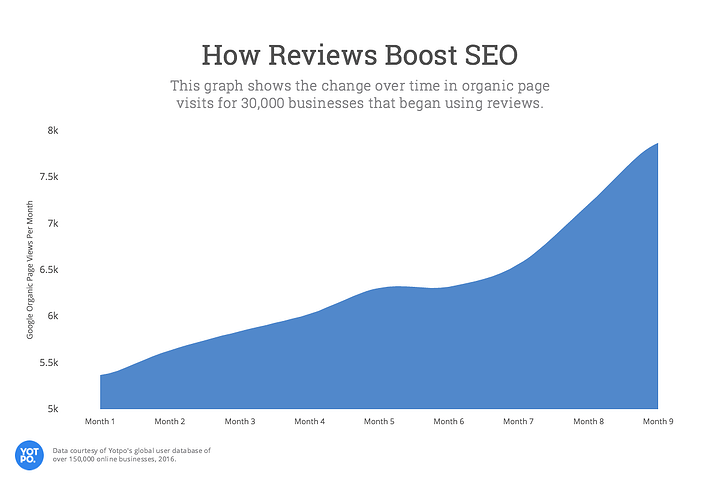
3. They allow you to engage with your customers
Ever wanted to find out what customers REALLY think about your business? Ever wanted a second chance to turn a negative experience into a positive one? Reviews are an opportunity to do just that.
Engaging with a review is a powerful way to boost your brand reputation and improve your business based on real, tangible feedback.
Whether it’s on Facebook, Google My Business or TripAdvisor, reviews are an avenue to respond to shoppers and demonstrate your stellar customer service. If you receive good feedback, you can leverage it to convert a one-time customer into a loyal customer or reinforce their positive reviews. And when you have a negative review, you can rectify the situation, explain your side of the story, or demonstrate that you take your customer feedback seriously.
4. Moving customers from consideration to conversion
Got a customer on the fence? 5-star reviews could make the difference between converting a browser to a buyer.
Once a customer has a product (or products) in mind, they turn to Google reviews and other platforms to help make their final decision. According to BrightLocal, the average shopper spends 13 minutes and 45 minutes reading reviews before deciding where to shop. What’s more, it takes an average of 10 reviews before a customer feels they can trust a local business.
In this instance, having more positive Google reviews or a higher average star rating can LITERALLY sway customers to shop with you over the competition.
But even if you don’t have hundreds of reviews online, having a few is better than none at all. Customers are 270% more likely to purchase products with just 5 online reviews, compared to a product with none whatsoever.
Where should you focus your online review efforts?
Now that we’ve covered the importance of reviews online, it’s time to look at the platforms themselves.
You have the best shot of racking up 5-star reviews when you focus your time and resources on a handful of platforms that matter the most to your customers. But to do that, you have to first figure out where they’re most likely to engage with your brand.
This largely boils down to who your target audience is, where they spend their time, and the type of product or service you offer. If you’re operating out of Australia, these 5 platforms should be at the top of your list.
1. ProductReview.com.au
ProductReview.com.au is arguably Australia’s biggest, most well-known review platform. The website has great SEO, a strong brand, and a reputation for driving traffic, leads and sales for businesses. There are categories for literally hundreds of different products, ranging from slow cookers to mattresses, cars and electronics. Customers can browse reviews by products, brands, ratings, or price range:

Despite its name, customers also provide reviews for service-based businesses on the platform, which makes it a one-stop-shop for shoppers looking for unbiased information on products and services.
2. Facebook
Facebook is another crucial review platform to concentrate your efforts on, especially if your customers spend a lot of time on social media. Facebook is the only social media platform out there that allows users to leave a review for a business and spread the word about their experience.
On top of improving your brand reputation, Facebook is also a great form of word-of-mouth marketing. If you get a positive review on Facebook, all of your customer’s friends will see it — which equals free advertising for your business. Shoppers also regularly check Facebook pages before making a purchase decision, so this one’s well worth investing your time in.
3. Google Reviews/Google My Business
One of the first things that shoppers do when researching any brand is to use the Google search engine. If your brand appears in search results along with a glowing 5-star rating, this will work wonders in leaving a great first impression on your customers.
Unless you’re not concerned about your presence in search results, you should absolutely be trying to get Google reviews for your company. Reviews on Google will also help boost your business’ rankings in local SEO, and appear in Google Shopping local search results.
4. Local directories
If you’re running a local business, like a cafe or medical centre, you need to get in front of customers in your area — and means putting your business on local directories as well as on Google My Business.
Directories like True Local, Yelp and Word of Mouth are great options for brick-and-mortar businesses. Just make sure to add all of your addresses as separate locations to maximise foot traffic and reviews for individual shopfronts.
5. Amazon, Etsy and eBay
Amazon, Etsy and eBay aren’t suitable for all local businesses, but they’re extremely important for eCommerce companies. If you’re selling your products on these platforms as well as on your own website, you definitely need to be pushing customers to leave reviews. Increasing your review count and the number of 5-star reviews will help improve your eCommerce SEO on that platform’s search engine, as well as help your conversion rates.
Bonus: Niche review sites
Facebook, Amazon, Productreview.com.au, local directories and Google reviews are some of the most popular review sites out there, but these are FAR from the only ones.
In addition to picking from the ones on this list, be sure to do your research on any niche websites for your industry or profession. For example, you might want to put your business up on TripAdvisor if you’re targeting out-of-town guests, or the Yellow Pages if you’re a local tradesperson.
How to generate reviews
Once you’ve chosen which platforms to focus on, you need to start racking up as many 5 star reviews as possible for your business. Thankfully, this process is relatively similar, whether you’re on Google reviews or ProductReview.com.au.
Here’s the good news: it’s as straightforward as setting up your platforms, getting the right processes in place, and simply asking (when the time is right). Follow this 4-step process to start generating more customer reviews ASAP.
1. Claim your business profile and get your custom review link
Before you get Google reviews or Amazon reviews, you need to verify your business and claim your listing. This is different for each platform — some like Google My Business require you to get a postcard sent to your operating address, while others like Facebook just need you to upload documents verifying your business identity.
Once you’ve got your account verified, it’s time to get your custom review link. This is an easy link that you can share with customers to give feedback, without needing to paste a lengthy URL or ask them to search for your business.
The process for getting your review link differs between channels, so visit the specific review platform to learn more:
- Google Reviews: Follow these instructions to set up a short Google review link via your Google My Business account. You can use this URL to quickly and easily get Google reviews from customers.
- Facebook: Share your Facebook business profile and turn on reviews. Customers can automatically leave reviews once they’re on the platform.
- ProductReview.com.au: Simply leave a link to your product on the platform directly, or embed a Write Review link directly in your eCommerce platform using these instructions.
- Amazon: You can either share a link to your unique product page for a customer to leave their review, or share Amazon’s universal review link.
- Yelp: Copy and paste your Yelp URL to allow people to leave a review directly on your business profile.
2. Get the timing right
It doesn’t matter if you’re looking to collect Google Reviews or Amazon ones. Timing can make the difference between customers actually leaving a review AND increase the chances of them leaving a 5-star review.
The goal is to ask for a review when your customer is at the height of their excitement and most engaged with your brand, product, or service. This could be:
- Asking them to leave a Google review immediately after making a purchase with your business in-store.
- Requesting reviews immediately after a customer receives their requested service (i.e. after getting a haircut or finishing up with a personal training session).
- Asking for reviews immediately when they receive a product from your business, if it was shipped to them.
- Waiting and asking for a review on Google/Amazon once they have enough time to experience your product or service, if the benefits aren’t immediate.
There’s no hard and fast rule on when the best timing is to ask customers to leave you a review, but there are a few sources you can go to in order to try and work it out.
If you have already got some organic Facebook or Google reviews, you can take a look at when these were posted and try to work backwards from when they became a customer.
Alternatively, conduct some market research with competing local businesses and see when they’re asking to get reviews, as this might be a good starting point for your business as well.
Another option could be to split test different times when asking for reviews, which works well if you’re asking customers via email. Send an email to half of your customers asking for a Google review immediately after they’ve purchased something, and another a few days after — then compare the average star rating to see if there’s any difference.
It’s also important to consider your customer life cycle and your product or service. For example, if you’re in hospitality, the best time to ask for a TripAdvisor or Google review would be immediately after customers pay for their meal, finish their tour, or check out of your accommodation. On the other hand, if you’re selling a mattress, your customers may need 6 weeks or more to adjust to their new bed, so sending a request to leave you a review at the 6 to 8-week mark might be ideal.
A final word: If you’re not sure, don’t sweat the timing too much. Countless studies have shown that actually asking people to leave you a review will give you a higher star rating, simply because the unhappiest customers will typically leave an unprompted 1-star review.
3. Ask for a review the right way
When you ask for a review, you should be specific with what you’re after, and personalise the review request for that customer and their unique purchase. The last thing you want is for a customer to leave a star rating without any context, or to get ignored with a generic templated request.
Keep your request simple:
- Lead by thanking them for shopping with you.
- Ask them to leave their star review and feedback to help ensure the experience is the best it can be.
- Highlight how quick and easy it is to provide feedback.
Make sure you also tailor the request to the specific product or service. This adds a personal touch to your review request and can serve as a handy reminder if it’s been a while since they shopped with you.
How you communicate with your customers also affects the likelihood of them leaving a review:
- Email is the easiest and preferred way for brands to request feedback as it can be automated and easy to follow up.
- If you have an app, you can send customers a push notification with a reminder to review your product or service.
- For service-based businesses, train your staff to ask for a review from every customer and place a card at the register.
- If you’re running an online store, leave a card in each package you ship out. This is an extremely effective way to ask for reviews when they’re at the height of their satisfaction.
Need inspiration? Here are some examples of star review requests in action:
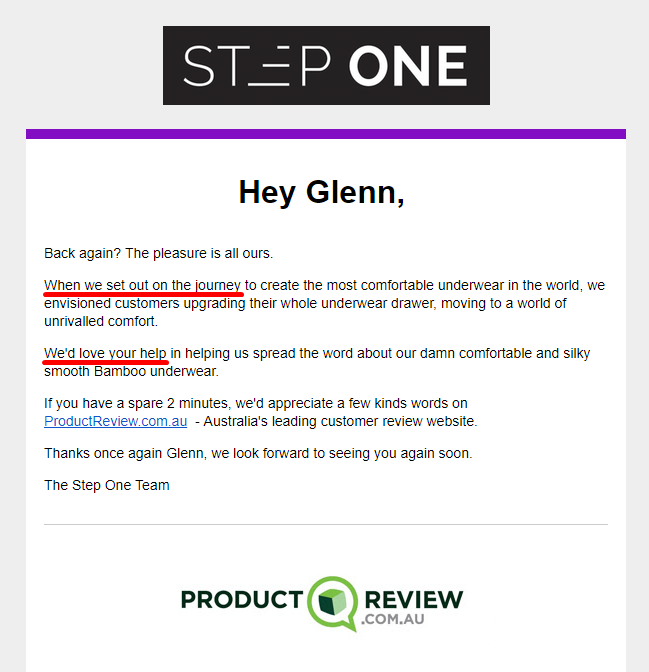
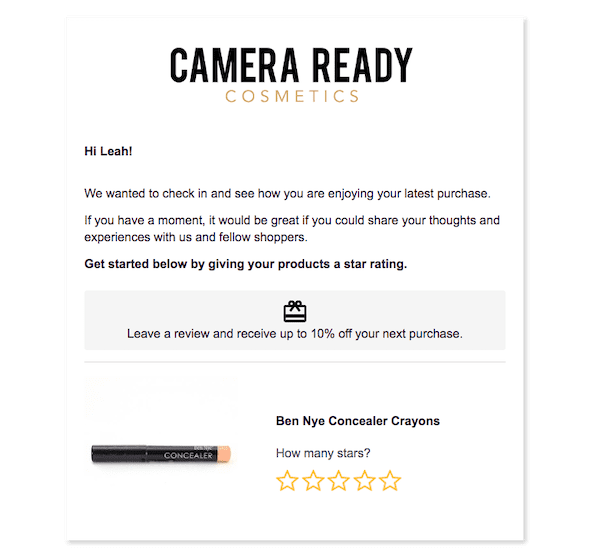
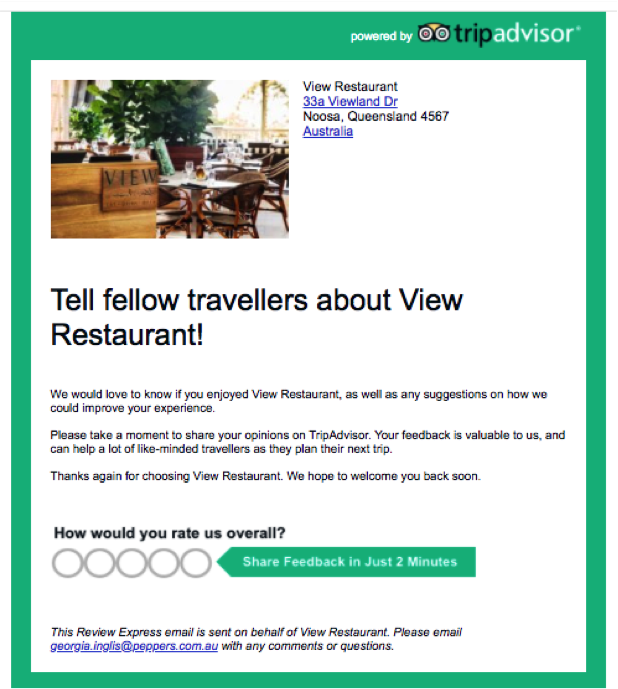
4. Push them to the right place to leave a review
Take a look again at those examples from before.
Notice something that they all have in common?
On top of being straightforward, each request is tailored to that business and the platforms they want people to leave a review on.
Make sure you push them to your preferred platform or platforms, whether it’s via your Google review link, Facebook, ProductReview.com.au, or somewhere else.
This ensures you’re focusing your time and effort on the websites that will make the most impact on your business. On top of this, it makes it easy for customers to leave a review – so they don’t have to search for your business review page.
Automation vs manual outreach
There are two ways to go about collecting customer reviews. You can:
- Automate the entire process from start to finish based on a customer journey flow.
- Manually contact each customer to ask them for their feedback.
Both have their merits. Automating your customer review requests for Google or Facebook will save you a lot of time and brainpower. It’s as simple as setting and forgetting, then monitoring the reviews as they come in. The only drawback here is you may not get to hear customer feedback firsthand BEFORE they leave their review, which means you have to read and address their feedback for the first time in a public forum.
Manual outreach is the exact opposite. You can ask each person about their experience to ensure they were happy, then ask them to leave a review. You’re likely to end up with fewer reviews in total but you’ll probably have more 5 star reviews.
So how do you decide which one’s right for your business?
Three factors: how much manpower you have, how many sales you make, and the state of your current reviews online.
If you have the time and resources on your team to manually reach out to each customer for Google reviews, go for it. On the other hand, if you’re making hundreds of sales per day on Amazon, you may not be able to reach out to each customer individually. In this case, automation is the way to go, with manual outreach for your high-value customers.
Manual outreach is also helpful if you need to improve your 5-star reviews, as you choose only to request reviews from happy customers. If you have a handful of reviews on Google, automation can help you increase your numbers — fast.
If you do choose to automate your reviews, here are a few tips to keep in mind:
- Keep it short and sweet. If a customer has to scroll to find your Facebook or Google review link, they may not leave a review at all. Make your communications as short and succinct as possible to get maximum uptake.
- Experiment with A/B testing. With automated outreach, you have the opportunity to split test different subject lines, email layouts, and send times to find out which one has the most impact.
- Provide a direct link to your review platform. Cut the guesswork to a minimum and give customers a direct link to leave a review. In an ideal world, they should be able to click on your call to action and immediately leave a star rating without needing to figure out what to do or navigate to additional pages.
- Use incentives. Offer your customers a little thank you for providing you with feedback. This could be a discount on their next shop, or a gift with purchase if they’re shopping in-store.
Dealing with negative reviews: 6 essential tips
No matter how hard you try to get 5 stars from every customer, the reality is that from time to time, you’ll wind up with a negative review. Don’t worry — the feedback doesn’t matter half as much as how you respond to it. These five tips will help you handle negative feedback effectively.
1. Keep calm and don’t retaliate
While it’s tempting to come back to the review with a negative response in return, this will do more harm than good. The way you respond to every customer review is a reflection of your business and your service. If you come back with an angry or sassy response, a potential customer might take one look and feel like your business doesn’t take customer feedback on board — or worse yet, that your business can’t be trusted to do what’s right by them.
The best thing to do is take a deep breath, reread the review, and prepare your public response. In other words, it’s time to take the high road.
2. Respond to reviews quickly
Time is of the essence when you get negative Google reviews, Facebook reviews, or reviews on any other platform. The longer you wait, the more likely it is that a potential customer will see that review and be deterred from shopping with your business.
Try to respond to a review on Google, Facebook, or any other platform within 24 to 48 hours of receiving the feedback. This gives you the best shot of doing damage control, and of rectifying the situation.
3. Thank them for sharing their feedback and apologise for their experience
This shows that you have acknowledged their point of view and that you take their feedback seriously. It doesn’t need to be over the top — something as simple as “Thank you for taking the time to write a Google review. We take feedback very seriously, and are sorry to hear you had an unpleasant experience with us this time…”
4. Tell them what you’re going to do to rectify the situation
It might be providing them with a discount on their next purchase, or reviewing your processes to ensure it doesn’t happen again.
Here’s a great example from Ocado:
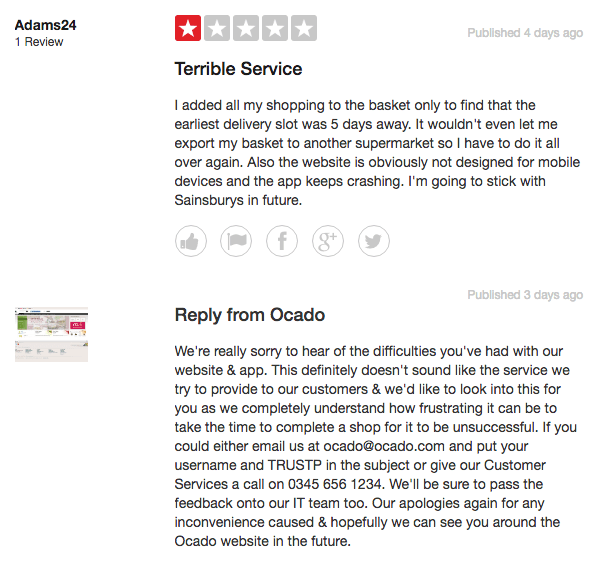
5. Explain the situation
Don’t agree with what your customer said? You’re entitled to provide your own explanation — provided you do so in a polite manner and don’t veer into defensive territory. Provide clarification into WHY the errors occurred, or where the misunderstandings took place like this company.
Here’s a great example of a company responding to one of its negative Google reviews:
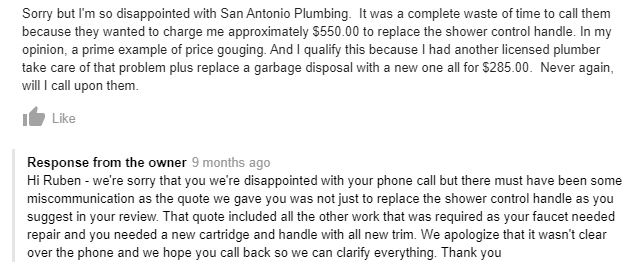
6. Take it offline if you can
This isn’t always possible, but if you can move the conversation to a private channel, do it. Negative reviews can quickly spiral into a blame game, and you don’t want your customers to see every part of the interaction.
Request that they private message you for more information, or let them know that you’ll be in touch with them if you already have their contact details on hand. Use this template if you’re not sure how to go about it:
Hi [Name],
Thank you for taking the time to leave a Google review. We are truly sorry that you had a less than ideal experience with [COMPANY NAME]. I will have a member of our team reach out to you directly to resolve the situation. Alternatively, please don’t hesitate to contact us on [NUMBER] if needed.
Thank you and our sincerest apologies again.
[NAME].
Make your 5-star reviews work harder for your business
With these tips and tricks, you’ll get 5-star reviews on Google before you know it. But the process to get Google reviews is just the beginning. Once you have a solid star rating, it’s time to leverage that positive word-of-mouth to help boost conversions and sales – and use it to skyrocket your presence to the top of Google’s search results page.
If you want to grow leads and sales, you need an integrated digital marketing plan that puts your customer reviews front and centre. Enter OMG. As Australia’s top-rated marketing agency, our gurus will help you maximise your star rating, improve your presence in Google’s local pack, and ensure that potential customers are seeing your glowing reviews when it matters, where it matters.
Get started with a FREE digital marketing audit and strategy session today.









